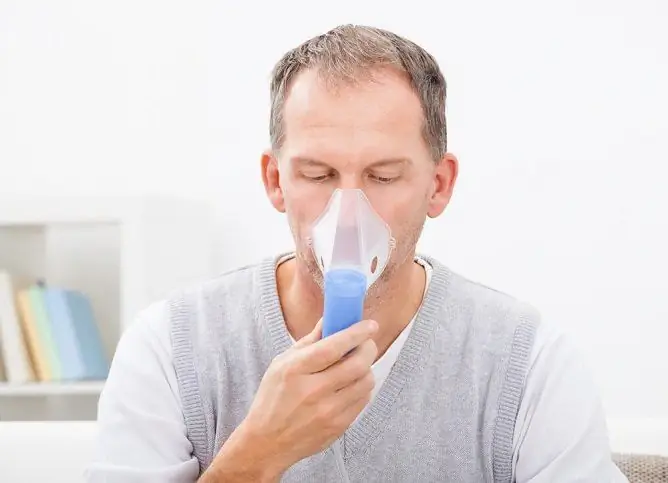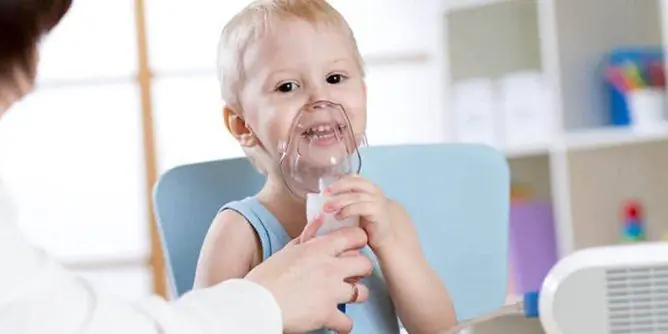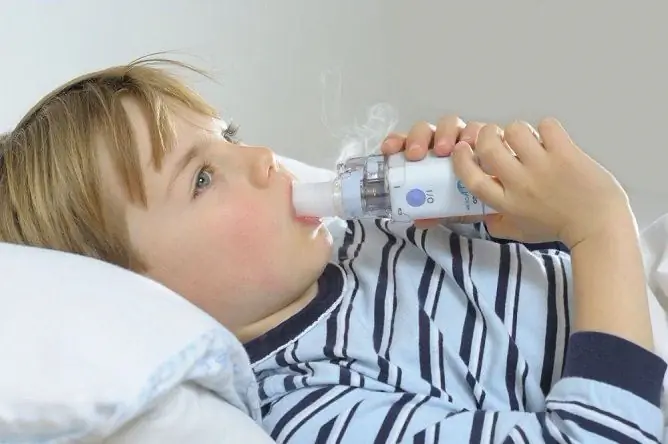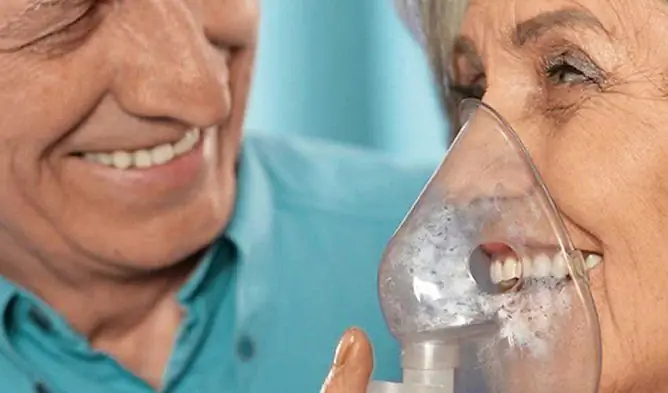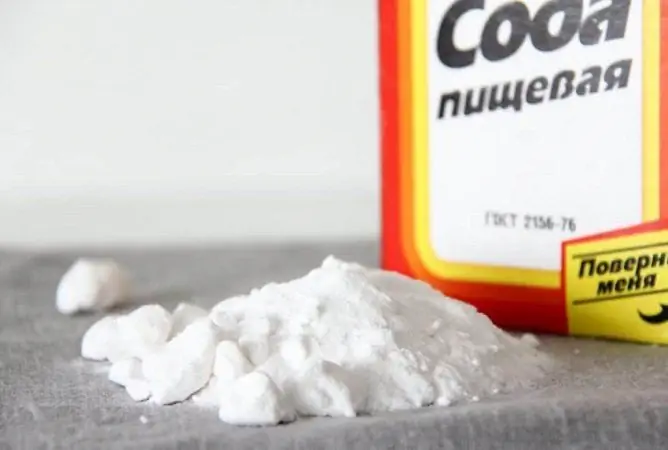- Author Rachel Wainwright [email protected].
- Public 2023-12-15 07:39.
- Last modified 2025-11-02 20:14.
Is it possible to do inhalations for angina: drugs, folk recipes
The content of the article:
- Contraindications for inhalation
- Nebulizer inhalation
- Steam inhalation for angina at home
- Video
Inhalation for angina (acute tonsillitis) can be included by an otolaryngologist in the therapy regimen if the patient has no contraindications to their conduct.

Inhalation is one of the most effective treatments for sore throat.
The most common causative agents of pathology are staphylococci and streptococci, which enter the body by airborne droplets or when using household items on which they are located.
Symptoms of acute tonsillitis are similar to those of a viral infection, but its course is more complex and requires an integrated approach to treatment. Angina is accompanied by severe sore throat, especially when food is swallowed, fever up to 39-40 ° C, chills, headache, general weakness and aching joints. During a physical examination, the patient shows an increase in the size of the palatine tonsils, their inflammation and redness, as well as the formation of abscesses on their surface.

The symptoms of tonsillitis depend on the form of the disease and are usually manifested by an increase in the size of the palatine tonsils
Disease therapy is usually carried out at home, hospitalization is necessary only in case of its severe course. Patients are prescribed antibacterial agents, antipyretics and pain relievers, and topical medications.
As auxiliary methods, rinsing, irrigation of the tonsils and inhalations are used, which relieve pain in the throat and facilitate the process of swallowing. The benefits of inhalation also lie in reducing the duration of the acute phase, the possibility of reducing the dose of medications taken and mitigating the manifestations of the disease. Along with conservative treatment, patients are also advised to rest in bed, drink plenty of fluids and a sparing diet.
Self-selection of therapy is not recommended, since with improper or untimely treatment started, the likelihood of complications is high - peritonsillitis, paratonsillar abscess, sinusitis, otitis media, lymphadenitis of regional lymph nodes, articular rheumatism, rheumatic heart disease and glomerulonephritis.
Contraindications for inhalation
It should be borne in mind that inhalations with purulent sore throat cannot be carried out in the acute period, since a directed heat flow can provoke a breakthrough of exudate, and it will spread through the bloodstream. The pathogenic flora as a result of this process can cause inflammation in other tissues and organs.

At elevated body temperature, inhalation is not recommended
Also, among the contraindications for inhalation in acute tonsillitis are conditions / diseases such as:
- arrhythmia and heart failure;
- body temperature over 37.5 ºС;
- neoplasms of the nasopharynx and respiratory tract;
- tendency to nosebleeds;
- high blood pressure;
- lung pathology: traumatic or spontaneous pneumothorax, bullous emphysema;
- individual intolerance to the components that make up the drugs for inhalation.
Nebulizer inhalation
At home, procedures can be carried out using a special device - a nebulizer. It separates the solutions into tiny particles and sprays them to an aerosol state, so that when inhaled, they fall exactly into the pathological focus.
For inhalation with a nebulizer for angina, medicines at room temperature are used, diluted with saline or water for injection. The prepared solutions can be stored for no more than a day in the refrigerator; before use, they should be warmed up to room temperature. Some medicines are ready for use within 1 hour after reconstitution. Herbal or oil inhalations cannot be carried out using the device. The duration of inhalations should not exceed 10 minutes, the number of sessions, depending on the course of the pathology and the patient's condition, varies from 2 to 6.

When inflammation spreads to the mucous membrane of the larynx, Berodual is prescribed
The drugs used for inhalation for angina include:
- Saline, mineral water (Borjomi, Narzan, Essentuki): reduce pain and swelling of the pharynx, heal microdamages of the throat mucosa;
- Miramistin: prevents the spread of infection, increases the body's local immune defenses, has antiseptic properties. When prescribing the drug to a child, it is diluted with Saline, in adults it is used in its pure form;
- Lazolvan: promotes excretion of secretions, reduces the viscosity of sputum. It is used for accumulation of mucus in the throat as an adjunct to the main inhalation solution;
- Berodual: relieves asthmatic spasm and dilates the bronchi. With angina, it is indicated for use in cases of spread of the focus of inflammation from the tonsils to the mucous membrane of the larynx;
- Chlorhexidine: antiseptic with bacteriostatic action. It is used in combination with Saline to reduce the activity of pathogenic microflora of bacterial, fungal or viral genesis.
Steam inhalation for angina at home
In the absence of a nebulizer, at home, you can carry out steam inhalations with the help of improvised means - a wide capacity, an ordinary kettle with a paper cone on a spout or a ceramic inhaler.

For steam inhalation, herbal infusions and essential oils can be used.
For procedures, decoctions of medicinal herbs, essential oils, boiled potatoes and other folk recipes can be used.
It is better to prepare decoctions of medicinal plants immediately before the procedure. For inhalation, 30 g of dry raw materials of chamomile, eucalyptus, sage, peppermint or calendula are poured with a glass of boiling water, simmered in a water bath for 20 minutes, then filtered and poured into an inhaler. If a wide container is used for this purpose, the patient tilts his head over it, covers himself with a towel and inhales vapors for 15 minutes.
The use of potato tubers for inhalation is widespread in acute tonsillitis. The vegetable with the skin is boiled in salted water until the liquid acquires a characteristic potato smell. Then the water is drained, the finished potatoes are slightly kneaded with a fork and sprinkled with soda. It is recommended to breathe it in vapor through the mouth, covering your head with a towel, for 3-5 minutes.
The most effective essential oils for angina are: tea tree, sea buckthorn, peach, menthol, fir, olive and rose hips. They have sedative, antispasmodic, wound-healing and antimicrobial effects.
In order to avoid burns of the laryngeal mucosa, it is important to add oil to water, the temperature of which does not exceed 65 ° C, and not to exceed the recommended dosage. Add 3-5 drops of oil to 1 liter of water and inhale the aroma exuded within 15 minutes.
Video
We offer for viewing a video on the topic of the article.

Anna Kozlova Medical journalist About the author
Education: Rostov State Medical University, specialty "General Medicine".
Found a mistake in the text? Select it and press Ctrl + Enter.

